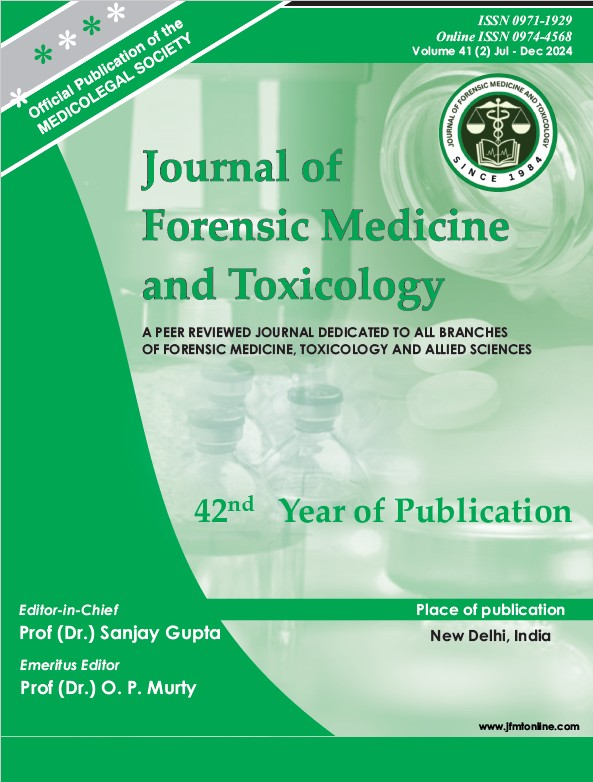AGE ESTIMATION OF THIRD MOLAR IN SOUTH INDIAN POPULATION BY ABFO RECOMMENDED MINCER METHOD – AN INDIAN SPECIFIC FORMULA
Keywords:
Orthopantomogram, Mincer method, Demirjian method, dental age estimation, forensic odontology, radiographic age estimation, third molar age estimationAbstract
Background: Third molar, being the only tooth which mineralize and erupt between 14 to 22 years, may be a significant parameter in identifying the individual of adolescence to young adult. As criminal laws are different for juvenile and adult, it is authoritative to differentiate child and an adult especially, when documentation is not properly maintained. Objectives: To determine the applicability of Mincer method of dental age estimation through third molars in South Indian population using orthopantomogram. Methodology: The study was conducted on 400 OPG (200 males, 200 females) of the age groups 14-22 years. They were divided into 8 groups (50 in each age group). Which were taken with PROMAX digital Planmeca Machine. Staging of all four third molars were done using Mincer adapted Demirjian et al. (1973) mineralization stages A H. Statistical analysis was performed, Descriptive statistics were obtained by calculating the means, standard deviations, Regression formulas were obtained for calculating dental age from tooth developmental stages, Empirical probability and accuracy was checked. Results: Result showed a strong relation of age with development stages of third molar teeth. The standard deviation of mean of tooth development stages is ± 0.5 years of age. Conclusion: As shown in the multiple and stepwise regression analysis lower left third molar are not significantly contributing for predicting the age, hence the use of one maxillary third molar and mandibular right third molar provided a statistically significant improvement in predictive accuracy, From the above observation, the present study predicted ages are closure to the observed ages as compared to Prediction values obtained by using Mincer’s formulae.
Downloads
References
Forensic Odontology: An Essential Guide, First Edition. Edited by Catherine Adams, Romina Carabott and Sam Evans, published in 2014.
Masthan KMK. (2009) Age and sex. Textbook of forensic odontology. New Delhi: Jaypee Brothers Medical Publishers (P) Ltd.
Acharya AB, Sivapathasundaram B. Forensic Odontology. In: Rajendran R, Sivapathasundaram B. Editors. Shafer’s Textbook of Oral Pathology. 5 th Ed. Elsevier: New Delhi; 2006
Brkic H., Milicevic M. and Petrovecki M. (2006) Age estimation methods using anthropological parameters on human teeth, Forensic Science International 162(1– 3): 13–16.
Acharya AB. Accuracy of predicting 18 years of age from mandibular third molar development in an Indian sample using Demirjian’s ten-stage criteria. Int J Legal Med. 2011; 125: 227–33
Albieri, R.J. and F.G. Araújo, 2010. Reproductive biology of the mullet Mugil liza (Teleostei: Mugilidae) in tropical Brazilian bay. Zoologia 27(3):331-340.
Schour L. and Massler M. (1941). The development of the human dentition, Journal of American Dental Association.
Garn, S.M.; Lewis, A.B.; Bonné, B. Third molar formation and its developmental course. Angle Orthod, Appleton, v. 32, n. 4, p. 270-278, oct., 1962.
Demirjian A. (1973) Tooth eruption in the French Canadian child, Journal Dentaire du Quebec 10(10): 9.
Demirjian A. and Goldstein H. (1976). New systems for dental maturity based on seven and four teeth, Annals of Human Biology 3(5): 411–421.
Amariti ML, Restori M, De Ferrari F, et al. Age determination by teeth examination: a comparison between different morphologic and quantitative analyses. Journal of Clinical Forensic Medicine. 1999 Jun; 6(2):85-89.
Heras, S. M.; Fortea, P. G.; Ortega, A. Third molar development according to chronological age in populations. Congresso de La Sociedad de Biofisica de España p. 106, 1987.
Mincer H., Harris E. and Berryman H. (1993). The ABFO study of third molar development and its use as an estimator of chronological age, Journal of Forensic Science 38(2): 379–390.
Bai Y., Mao J., Zhu S. and Wei W. (2008) Third-molar development in relation to chronologic age in young adults of central China, Journal of Huazhong University of Science and Technology – Medical Sciences 28(4).
Tonin, Age estimation based on the stage of mineralization of Third molars on orthopantomograms, Biosci. J., Uberlândia, v. 32, n. 3, p. 805-812, May/June. 2016
Panchbhai AS (2012) Radiographic Evaluation of Developmental Stages of Third Molar in Relation to Chronological Age as Applicability in Forensic Age Estimation. Dentistry S1:002. doi:10.4172/2161- 1122.S1-002
Yun-Hoa Jung, Radiographic evaluation of third molar development in 6- to 24-year-olds, Imaging Science in Dentistry 2014; 44: 185-91
Priyadharshini KI, Idiculla JJ, Sivapathasundaram B, Mohanbabu V, Augustine D, Patil S. Age estimation using development of third molars in South Indian population: A radiological study. J Int Soc Prevent Communit Dent 2015; 5: 32-8.
Sisman Y, Uysal T, YagmurF, Ramoglu. Third-molar development in relation to chronologic age in Turkish children and young adults. Angle Orthod. 2007; 77:1040 5.
Teelana Boonpitaksathit, Dental age assessment of adolescents and emerging adults in United Kingdom Caucasians using censored data for stage H of third molar roots, European Journal of Orthodontics 33 (2011) 503–508
Sabitha Devi, Third molar as a diagnostic tool for age estimation in forensic odontology: An exploratory study. Sch. Acad. J. Biosci., 2017; 5(5):337-340,
Solari A. and Abramovitch K. (2002), The accuracy and precision of third molar development as an indicator of chronological age in Hispanics, Journal of Forensic Sciences 47(3): 531–535.
Muawia A. Qudeimat & Faraj Behbehani, Dental age assessment for Kuwaiti children using Demirjian’s method, Annals of Human Biology, November– December 2009; 36(6): 695–704.




